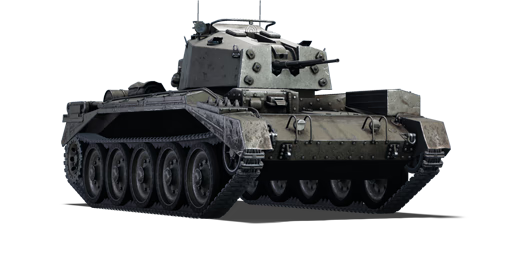



The Crusader III Anti-Aircraft Mark II is the second anti-air modification of the Crusader III, which is the third variant of the A15 Crusader cruiser tank family. It is armed with two 20 mm Oerlikon anti-aircraft autocannons. The turret was a small polygonal turret with good armour but poor situational awareness for identifying approaching aircraft. As a result of Allied air superiority over the battlefields of north-west Europe, none of these Crusader Anti-Aircraft modifications saw considerable use against aircraft, however, a few were used against ground targets, most notably by the 1st Polish Armoured Division.
Introduced in Update 1.55 "Royal Armour", the Crusader III Anti-Aircraft Mark II has far superior anti-aircraft capability than its predecessor, the Crusader III Anti-Aircraft Mark I. Despite having a smaller calibre anti-aircraft armament, it has a far higher firing rate. This results in substantially more extensive coverage against enemy aircraft on the battlefield. However, the decrease in armament calibre also results in a decrease in anti-tank capability, as the Crusader III Anti-Aircraft Mark II will struggle to engage practically any type of enemy armoured vehicle. Players do not have to worry about strafing fighters because they rarely cause major harm to the crew due to the vehicle's closed design. However, some planes equipped with cannons can be lethal since they can penetrate the armour while strafing.
| Belt | Belt filling | Armor penetration (mm) at a distance: | |||||
|---|---|---|---|---|---|---|---|
| 10 m | 100 m | 500 m | 1000 m | 1500 m | 2000 m | ||
| AP-T/HEF-I/AP-T | 38 | 35 | 23 | 14 | 9 | 5 | |
| HEFI-T/HEF-I/HEF-I | 4 | 4 | 4 | 4 | 4 | 4 | |
| AP-T | 38 | 35 | 23 | 14 | 9 | 5 | |
| Belt | Belt filling | Armor penetration (mm) at a distance: | |||||
|---|---|---|---|---|---|---|---|
| 10 m | 100 m | 500 m | 1000 m | 1500 m | 2000 m | ||
| IT/AP/AP | 13 | 12 | 7 | 3 | 2 | 0 | |












Mobility | |
|---|---|
Protection |
|---|
Firepower | |
|---|---|